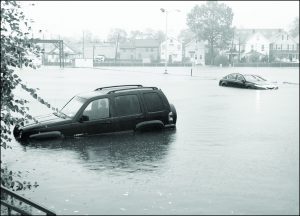
Thomas Boucher
Transcript Correspondents
While blustery side effects from Hurricane Sandy stormed through Delaware, many Ohio Wesleyan students from the East Coast were absorbed by thoughts about their families back home.
Freshman Sarah Shulman said she was scared for all her friends and family in Brooklyn that she was unable to contact during the storm.
“It drove me crazy being so far away and not being with my family,” she said.
Zone A, where most New Yorkers live, was completely evacuated.
However, Shulman’s family did not evacuate because they live in Zone B.
Her apartment building was a safe home for people who were evacuated. To prepare for the storm her family bought water, a small portable stove, flashlights and batteries.
Shulman’s apartment was not damaged but her aunt’s apartment was completely flooded and ruined.
Shulman was thankful that her Aunt had evacuated. Several of her friends’ homes were also flooded. Shulman was in Hurricane Irene last August.
“I thought Sandy was going to be just like Irene, but this was closer to Katrina,” she said.
According to Shulman, almost everything in New York was underwater.
“It’s so scary; you never know what nature has in store,” she said.
Freshman Miranda Dean, from Providence, R.I., was also affected by the storm.
Her family is safe and her house was not damaged. However, her neighborhood suffered damage. There was flooding in other houses and a tree fell on her neighbor’s roof.
There were warnings for Dean’s family to evacuate, but they decided to stay. Dean said her family stocked up on water and batteries to prepare for the storm.
Dean said it was weird being away from her family during the storm. She was a little bit nervous for them, but also jealous because she finds storms exciting.
According to Dean, climate change might be a factor in storms hitting the East Coast.
“Two or three years ago New England didn’t get any of these big storms,” she said.
Freshman Hannah Simpson lives in Lincroft, N.J. A tree fell in her driveway, but her family is fine. She said her family has not had power since Oct. 29; however, she could contact them by cell phone during the storm.
Simpson’s grandparents live in Lavallette, NJ. They were evacuated and also survived the storm.
According to Simpson, Hurricane Irene also affected her and her family in 2011, but Hurricane Sandy caused much more damage.
She knows of several schools in her area that were cancelled—one is cancelled until November 13.
“It was so eerie to watch Asbury Park and Seaside Heights, two beach locations not far from where I live, being torn apart by the hurricane on T.V. while I was here in Ohio,” Simpson said.
Hurricane Sandy’s strength ranged from category one to category three. The diameter of tropical storm winds was more than 900 miles with a nine foot storm surge, which resulted in the highest recorded tide, reaching 13.88 feet.
Senior Erik Pramschufer from Pleasantville, N.Y. said his house didn’t suffer any permanent damage.
“Thankfully my house was still fully intact but my entire town lost power for three days,” Pramschufer said.
